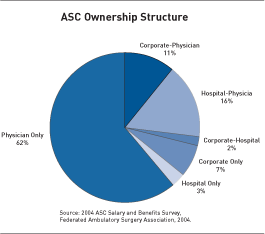(continued...) Return to Page 2
SAFETY IN NUMBERS
While it is true that most ASC’s do
not have the capabilities of dealing withpost-operative emergencies, the potential
risks can be minimized by honest and open
communication between doctor and patient.
Discussing previous medical history
is crucial when determining eligibility
for out-patient procedures, and there are
guidelines that physicians must follow in
making these
decisions. For
the most part,
older patients
or those who
have previous
medical conditions
could be
considered
at higher risk
for an out-patient
surgery setting.
If that is
the case, a patient
will be referred
to a traditional
hospital.
Overall, the younger
and healthier you are, the better your
candidacy for an ASC.
By law, ASCs cannot admit patients
that they consider to be at risk for life
threatening surgical complications, as
well as those that involve the direct involvement
of major blood vessels or extensive
invasion of body cavities. In addition,
there are special rules with regard to
children, which include a ban on treating
children less than six months old.
Furthermore, ASCs are highly regulated,
and most states require these centers
to be licensed and certified by Medicare.
Compliance with these standards is constantly
monitored. Out-patient standards
that apply to hospitals are the same for
ASCs, and all are required to maintain
accurate medical records, as well as infection
control and anesthesia standards.
PRESCRIPTION FOR SUCCESS
According to a recent report by the
American Academy of Orthopaedic Surgeons,
a shift is taking place in the ASC
market. The focus is on developing outpatient
surgery centers that remind the
patient that the facility is affiliated with
a particular health care organization.
In addition, the future lies in much
larger facilities that can offer a variety
of services, known as Multiple-Service Ambulatory Care Centers (MACCs).
Many of these facilities are already in
place, but as of today there are none
in the Kansas City area.

Recent advances of note include expanding
insurance coverages at ASCs to
include an additional 790 procedures
over the next four years, although some
exclusionary provisions apply. Currently
the Centers for Medicare and Medicaid
Services cover more than 2,500 procedures
that are preformed in out-patient
surgery facilities, and as more are
added, the need for additional centers
will be created.
Forecasted growth for these centers
in the next seven to ten years could be
as much as 47 percent, according to a
recent report. As of 2003, there were
approximately 3,700 such centers in
the United States; a major leap from
275 in 1980 and 1,450 in 1990.
Several factors comprise the increased
demand for out-patient surgery
centers. New and improved anesthesia
techniques have made certain types of
surgeries more routine, affording the
patient less pain and less recovery time.
With fewer anesthesia-related deaths,
as well as reduced post-operative observation
times, patients now have a viable
alternative to former ‘hospital-only’ offering.
A shift in the number of available
practicing physicians and oversupply
of hospital beds by early 2000
created a competition for surgical patients
between surgeons and hospital
facilities.
The continued commercialization of
health care has led to the increase of investor-
owned ambulatory centers. Some
conflict of interest concerns have arisen
from the fact that more than 60 percent
of doctors are investors or full owners in
the ASCs to which they refer their
surgical patients. In an article by William
J. Lynk and Carina S. Longley, the
affect of physician-owned surgicenters
is examined in detail, citing that “the
complimentary relationship between the
surgeon and hospital shifts, when the
referring physicians acquire personal
financial ownership interests in ASCs
that compete with the hospital facilities
at which the physicians continue to
practice.” Although their research was
specific to a narrow set of hospitals, their
study raises an interesting question with
regard to where a sur-geon’s alliance
should ultimately rest. Thankfully, guidelines
are in place to ensure decisions
such as these are based on the best interests
of the patients, and could spur
hospitals to re-evaluate their own operating
procedures.
As far as the future of ambulatory
surgical centers in concerned, the prognosis
is good that this trend will continue.
Keith Chambers of HCA-Midwest
agrees.
“As more and more healthcare is
beginning to shift outside the walls of
the hospital, we will continue to see
better outcomes, less infection, as well
as more efficiency,” states Chambers.
«March 2008 Edition |

